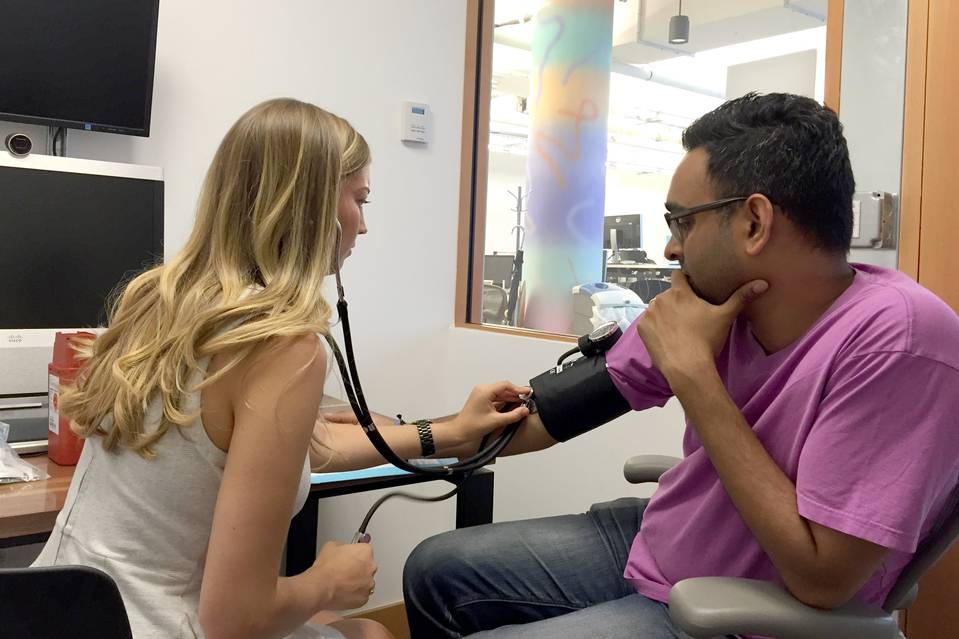
Darren Gold had a stomach virus the first time he used an app called Heal to summon a doctor to his Beverly Hills home. He liked the Stanford-trained doctor who showed up so much that he called Heal again when his 2-year-old son had a fever, and again when the whole family had colds.
The charges—$99 each for the first two visits; $200 for the family—weren’t covered by insurance, but Mr. Gold, who owns a corrugated-box company, says that was still a bargain compared with taking time off work to go to the doctor. “Now, whenever my son bumps himself, he says, ‘Daddy, we need to get the doctor here,’ ” Mr. Gold says.
Heal is one of several startups putting a high-tech spin on old-fashioned house calls—or “in-person visits,” since they can take place anywhere. The services provide a range of nonemergency medical care—from giving flu shots to treating strep throats and stitching lacerations—much like a mobile urgent-care clinic.
The companies use slightly different models. Pager, in New York City, dispatches doctors or nurse practitioners via Uber, for $200. Heal, in Los Angeles, San Francisco and Orange County, Calif., promises to “get a doctor to your sofa in under an hour” for $99. (A medical assistant goes along to do the driving and parking.)
RetraceHealth, in Minneapolis, has a nurse practitioner consult with patients via video (for $50), and only comes to their homes if hands-on care like a throat swab or blood draw is necessary (for $150).
An Uber-type service to allow doctors to make house calls? There’s an app for that. Pager.com Chief Technology Officer Oscar Salazar and WSJ’s Tanya Rivero discuss the site’s service to doctors and patients and its newest round of funding.

Atlanta-based MedZed sends a nurse to a patient’s home to do a preliminary exam. Then the nurse connects via laptop with a doctor who provides a treatment plan remotely. Several Atlanta practices use MedZed as a way to offer patients extended hours without having to keep their offices open.
Most of the services don’t accept insurance, but they say patients can pay with health savings accounts or submit out-of-network claims.
Such ventures are fueled by a confluence of trends, including growing interest in the so-called sharing economy, where technology connects providers with excess capacity and consumers who want on-demand services. Many doctors and nurses who work for hospitals are eager for extra work in their off-hours, the companies say. The services carry malpractice insurance, but say overall low overhead keeps prices down.
And thanks to the boom in mobile-medical technology, providers can carry key equipment with them, from portable blood analyzers to hand-held ultrasounds.
The companies are attracting venture-capital investment and partnerships with hospital systems, which increasingly see in-home care as a way to reduce unnecessary ERs visits and readmissions.
 Health systems “are experimenting with many different options to get patients the right level of care,” says Pam Nicholson, senior vice president for strategic initiatives for Centura Health, Colorado’s largest hospital chain. Centura is teaming up with True North Health Navigation, a Denver startup that offers on-scene care to 911 callers as an alternative to a costly ambulance ride to the ER. Centura plans to offer True North’s home-care services to its own employees and other patients whose costs it is responsible for under insurance contracts.
Health systems “are experimenting with many different options to get patients the right level of care,” says Pam Nicholson, senior vice president for strategic initiatives for Centura Health, Colorado’s largest hospital chain. Centura is teaming up with True North Health Navigation, a Denver startup that offers on-scene care to 911 callers as an alternative to a costly ambulance ride to the ER. Centura plans to offer True North’s home-care services to its own employees and other patients whose costs it is responsible for under insurance contracts.
House calls, which accounted for 40% of all doctor visits in 1930, dwindled to less than 1% by 1980 as physicians found it far more efficient to see 20 or 30 patients a day in an office than just a handful in their homes. But in-home care is starting to be seen as cost-efficient again—particularly for the most expensive patients. A pilot project providing in-home care for 8,400 Medicare patients with multiple chronic-conditions cut costs by more than $3,000 per patient, the agency reported in June.
Analysts say it’s unclear whether many of the new on-demand services will reduce costs for those chronically ill patients—or mainly make it more convenient for the healthy and wealthy to get care they could have gone without.
Pager, which has treated about 5,000 patients in New York’s five boroughs since its founding last year, says a typical patient is a young mother with one sick child and others she doesn’t want to bring along to the doctor’s office too or leave at home. “Health checks,” in which a nurse does cholesterol, blood pressure, blood sugar and other tests for $75, are also popular—even in office settings.
On one such visit recently, Kunal Merchant, a 34-year old Facebook executive with a new baby on the way, wanted to be sure he was healthy, but didn’t want to take hours off work to visit a primary-care physician he barely knew. So he booked an office conference room, and scheduled a Pager visit. Registered nurse Eve Rorison brought all the gear she needed to check his blood sugar, blood pressure, cholesterol, heart rate and BMI, in her backpack. About 15 minutes and one finger prick later, she declared, “You’re very healthy—keep up the good work.”
 Many of the services bill themselves as an “Uber for health-care”—but to date, they haven’t sparked the kind of opposition from traditional doctor practices that the ride-sharing service has from taxi drivers. That’s in part because the house-call companies are new and small and in part because they employ licensed medical professionals—generally doctors, nurses and nurse practitioners with experience in primary care or emergency medicine, looking to earn extra money in their spare time. The providers generally take home about half of the house-call fee, and make fewer than 10 calls a day. But many say they enjoy the chance to take their time with patients. “I love my Pager shifts—it’s back to real medicine, just you and the patient,” says Kimberly Henderson, an ER physician at Beth Israel Hospital in New York who works for Pager one or two days a week.
Many of the services bill themselves as an “Uber for health-care”—but to date, they haven’t sparked the kind of opposition from traditional doctor practices that the ride-sharing service has from taxi drivers. That’s in part because the house-call companies are new and small and in part because they employ licensed medical professionals—generally doctors, nurses and nurse practitioners with experience in primary care or emergency medicine, looking to earn extra money in their spare time. The providers generally take home about half of the house-call fee, and make fewer than 10 calls a day. But many say they enjoy the chance to take their time with patients. “I love my Pager shifts—it’s back to real medicine, just you and the patient,” says Kimberly Henderson, an ER physician at Beth Israel Hospital in New York who works for Pager one or two days a week.
Still, Alan Ayers, a spokesman for the Urgent Care Association of America, a trade group, says urgent-care clinics provide all the same services that the house-call companies do, far more efficiently. He also asks, “What quality control is there over the clinical environment in someone’s home? Does it have the right light? Is it sanitary?”
What’s more, some office-based physicians fear that dialing up doctors like taxi rides will further fragment health-care delivery and interfere with doctor-patient relationships. “Someone who knows you well might say, ‘Why would you need to be seen three times in four weeks for a cold? Maybe it’s really heart failure’,” says Robert Wergin, president of the American Academy of Family Physicians, who practices in rural Milford, Neb.
The on-demand house-call companies counter that they will send reports to patients’ regular physicians on request. They also say that most people who try the services become repeat users. “Once you’ve had pizza delivered, you rarely go pick up pizza again,” says Thompson Aderinkomi, a health-care economist who founded RetraceHealth in 2013.
House-call providers also say that even if conditions aren’t ideal, they get to know patients far better seeing them at home than they would in a hurried office or ER visit.
Caren Misky, a nurse practitioner with True North Health Navigation in Denver, says she recently responded to a call where an Alzheimer’s patient had fallen and cut his head. She was able to staple his wound at the kitchen table while he had breakfast. “His wife said the last time that happened, they spent eight hours in the ER and had a $10,000 bill,” Ms. Misky says.
True North is one of the few services that is reducing ER use. It was founded in part because local fire chief Rick Lewis wanted to offer 911 callers who had minor, nonemergency health issues an alternative between no care and a costly ambulance ride to the ER.
Now, if the 911 dispatcher determines that the caller has a low acuity case, the True North mobile unit goes to the scene along with the fire department’s paramedics. Once the paramedics confirm the situation isn’t life-threatening, the caller can choose between being treated by a nurse practitioner on the spot, for $200 to $300, (which is covered by most Colorado insurance plans) or going by ambulance to the ER, which typically costs $3,000 or more.
“You essentially get the same person who would see you in the ER, with a lot of the same equipment, for a lot less money than you’d pay there,” says Chief Lewis.
True North, which is changing its name to Dispatch Health, is expanding so that Denver residents can summon at-home visits via phone, app or Web without calling 911.
CEO Mark Parther says his teams have treated about 400 911 callers who would otherwise have gone to the ER since 2013. He adds: “We get a thank-you note every week.”
Source: Wall Street Journal






